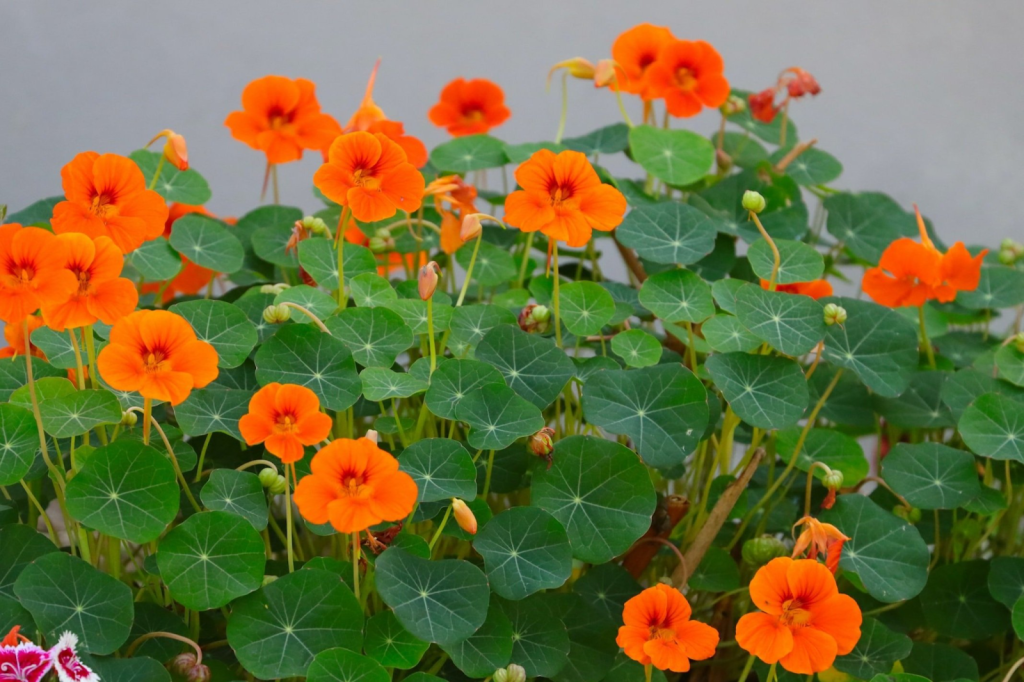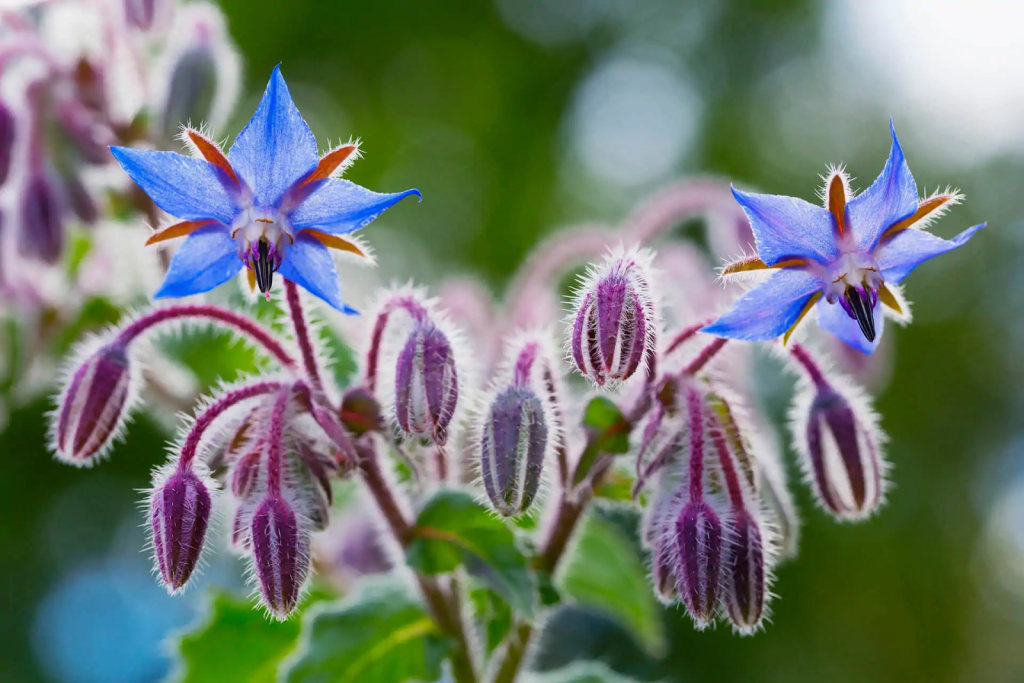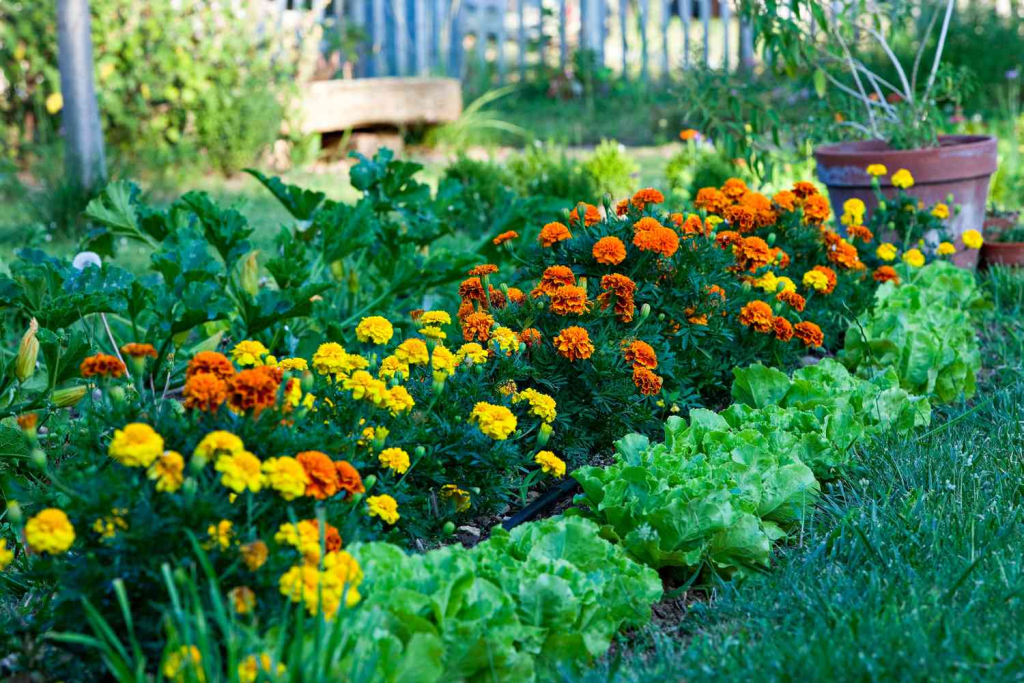Bright blooms tucked between rows are more than eye candy. They boost vegetable garden yields and curb insects naturally. This approach, known as companion planting, uses each blossom’s special talent.
French marigolds release root chemicals that slash root-knot nematode damage to tomatoes and peppers, cutting pest issues before it starts. Nasturtiums work as trap crops, luring aphids away from cabbages and cucumbers so foliage stays clean.
Blue-star borage pulls in pollinating bees and strengthens nearby tomato growth, translating extra blooms into heavier harvests. By positioning the right flowers beside specific vegetables, gardens gain natural pest control without extra sprays plus a steady flow of pollinators.
Why Planting Flowers with Vegetables Boosts Yields
Colorful calendula planted as borders draw bees minutes after opening, turning beds into lively work zones. This simple planting tweak showcases the benefits of companion flowers treasured by many growers. Sweet alyssum perfumes the air and lures hoverflies whose larvae devour aphids on kale and peppers.

Towering sunflowers host extra bees, firmly attracting pollinators that boost marketable fruit weight. Lupines share their soil nitrogen dividend, feeding leafy greens and thickening humus (dark organic matter in soil) for future crops.
Mixing these blooms disrupts pest cycles, supports predators, and knits a more resilient garden ecosystem balance that trims chemical use and lifts yields. Season after season the payoff shows in heavier baskets at harvest.
Marigolds and Tomatoes: A Pest-Control Power Duo
Bright orange blooms do more than decorate tomato rows. Planting marigolds and tomatoes side by side forms a living shield that keeps troublemakers away while inviting garden allies in.

French marigolds release limonene and alpha-terthienyl, chemicals proven to chase off whiteflies above ground and root-knot nematodes below, making them reliable natural pest repellents. Their nectar-rich flowers pull in ladybugs, hoverflies, and tiny parasitic wasps that feast on aphids and hornworms, giving plants round-the-clock bodyguards.
Fewer pests mean less leaf stress, steadier photosynthesis, and noticeably heavier harvests. The duo are prized as classic plant companions, because the compact marigold canopy shades soil, reduces weed growth, and keeps fruit cleaner during summer rains.
Nasturtiums for Cucumbers and Peppers: The Ultimate Trap Crop

Bright orange nasturtiums pull double duty beside cucumbers and peppers. First, their peppery scent and broad leaves lure aphids, whiteflies, and even cucumber beetles away from tender vines, giving cucumber plants natural pest control.
This nasturtium companion planting works because the flowers act like a living sticky trap and pests settle on the sacrificial blooms, leaving vegetables mostly untouched. Second, nasturtiums invite bees and hoverflies that boost pollination, so fruit bears faster and heavier.
Be sure to plant a small ring of nasturtiums 12 to 18 inches from each pepper row. This simple tweak for companion planting peppers and cucumbers can raise yields, cut damage, and add edible, spicy petals to salads all season.
Borage: A Blooming Friend for Squash Plants

Bright blue borage flowers lure bees and butterflies straight into the squash bed, turning blossoms into fruit. That rush of pollen delivery boosts yields. The plant’s deep taproot mines calcium and potassium then sends those nutrients upward.
Recycle chopped borage leaves as mulch into the topsoil, fertilizing vines naturally. As the broad leaves sprawl they blanket bare earth, locking in moisture and shutting out weeds, so less water and hand-weeding are needed.
Put these traits together and borage sits high on the list of reliable squash garden companions, giving healthier plants and bigger harvests. Borage seeds germinate quickly and since it is a perennial it annually self-seeds, so one sowing can keep future beds buzzing without extra effort.
Sunflowers: Enhancing Pea Productivity

Sunflowers tower beside legumes and pull in buzzing allies every pea flower needs. The broad, nectar-rich blooms act like neon signs for bees and butterflies, boosting visits to nearby vines. More visits translate straight into stronger pea yields, and sturdy stalks double as a free trellis for climbing varieties, saving on stakes.
During midsummer heat they even cast a cooling speck of shade that conserves moisture. Plant a strip of sunflower on the north side so they won’t steal midday light yet still slow drying winds. Expect a steady hum, because these giants excel at attracting garden pollinators.
Calendula: Strengthening Brassica Health

Tucking bright calendula between cabbage rows often feels like installing tiny guards. The blooms give off a resinous scent that confuses cabbage loopers and whiteflies while luring hoverflies and parasitic wasps hungry for aphids. That’s classic calendula pest control in action.
You can expect cleaner leaves and fewer sprays after sowing these golden flowers beside broccoli and kale. Fallen petals and chopped stems break down fast, feeding earthworms and raising organic matter, which in turn lifts nitrogen and softens clay soils.
Because calendula thrives in the same cool months as cabbage, broccoli, and kale, it slots naturally among the best brassica companion plants. Scatter a handful of seeds each spring and watch brassicas bulk up with fewer pests and richer soil.
Essential Tips for Successful Flower-Vegetable Pairing

Match flowers and vegetables like dance partners, balancing height, light, and season. Start with marigolds around tomatoes or beans. Their scent confuses root-knot nematodes and aphids, protecting the crop and needing the same full-sun spot.
Ring salads with sweet alyssum to pull in ladybugs that feast on aphids while sharing the lettuce’s cool-season timetable. Thread nasturtiums under cucumbers or squash. Sprawling vines lure cabbage moth caterpillars away and fit under trellises without stealing light.
Keep rows loose enough for airflow yet close enough for pollinators to hop. Stagger bloom times so at least one flower is open through the vegetable’s fruit-set window. Plan beds in blocks, grouping crops with identical water and soil needs to simplify care.
Use these flower vegetable pairing tips, lean on successful companion planting, then refine beds with smart garden layout strategies.
Planning Your Garden Layout for Optimal Companion Planting
Good garden layout planning starts with tracking sun movement. Tall tomatoes or trellised beans stay on the north edge so lower lettuce, carrots, and marigolds soak up full light. Beds run east to west with twelve to eighteen inch paths for pruning, watering, and harvest.
Slip pest-repelling blooms such as marigolds or nasturtiums between every third tomato, matching flower spread to vegetable spacing so roots share nutrients, not fight. Follow seed-packet distances to keep airflow because cramped leaves invite mildew.

Stagger heights by placing ground-hugging calendula beside mid-level peppers and then the trellis row, creating a living ladder that still lets pollinators in.
Overcoming Common Companion Planting Challenges
Heavy feeders such as tomatoes alongside basil may empty the soil pantry before flowers are set. Alternate rows with nitrogen-fixing peas, then top-dress compost mid-season.
Potatoes sulk when marigolds crowd their roots, so keep the blooms in nearby borders where their scent still repels aphids. Companion planting challenges often include surprise visitors like aphids.
Interplant nasturtiums as a trap crop, then hand-remove insects before they hop to brassicas for quick garden pest solutions. If a pairing fails, swap the flower or shift planting dates. This simple tweak usually restores balance without chemicals.
Real-Life Success Stories of Flower and Vegetable Companions
In Brighton, U.K., borage tucked beside strawberries translated into 35 percent more fruit, and 32 percent increased yield by weight.

Meanwhile, nasturtiums trailing under cucumber arches lured aphids away and kept vines producing. A result now shared as one of the companion planting success stories that saves on sprays.
Seasoned mentors use these organic gardening examples when urging new growers to weave flowers among crops, and they keep a pocket list of proven flower pairings like marigold-tomato, borage-strawberry, and nasturtium-cucumber so any bed, even a balcony box, can repeat the gains.
Conclusion: Boost Your Garden Yield with Flower Companions
Bright marigolds, sweet alyssum, and bee-loving borage do more than dress up beds, they invite hoverflies, lacewings, and pollinators that prune pests and set more fruit, helping boost garden yields without extra spray.
Their roots share space kindly, add organic matter, and even fend off soil-dwelling nematodes, ticking key boxes for sustainable gardening. It is the kind of effective companion planting veteran growers rely on, as nasturtiums draw aphids away from beans while calendula keeps flea beetles busy on its petals.
Slip a few flowers among veggies today and drop your success stories in the comments below!


